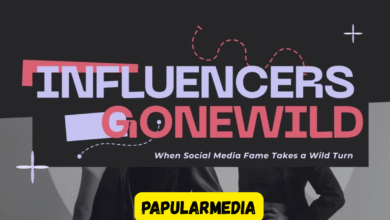InfluencersGoneSild: Exploring the Viral Sensation and Digital Culture Shift

Introduction to InfluencersGoneSild
InfluencersGoneSild In the fast-paced world of digital content and social media, new terms often rise to prominence, catching the attention of audiences across the globe. One such emerging phenomenon is “InfluencersGoneSild”—a phrase that, while seemingly a typographical variation of similar viral trends, has evolved into a niche concept representing the chaotic, unfiltered, and controversial side of internet influencers. While its exact origins remain somewhat ambiguous, InfluencersGoneSild has come to embody a broader commentary on internet fame, accountability, and the darker edges of influencer culture.
The Evolution of Influencer Culture
Social media influencers began as relatable individuals who shared glimpses of their everyday lives, passions, and expertise with online audiences. Platforms like Instagram, YouTube, and TikTok enabled everyday people to cultivate large followings, turning them into trendsetters and digital celebrities. Over time, influencer culture shifted from authenticity to monetization. Sponsored posts, brand partnerships, and curated content turned personal platforms into business ventures.
This evolution created a paradox. On one hand, influencers remained accessible and personal. On the other hand, the increasing commercialization and performance-driven nature of the content made it less genuine. This contradiction laid the groundwork for public scrutiny, controversy, and disillusionment—a space where the idea of “InfluencersGoneSild” thrives.
What Does “Sild” Symbolize?
Though “Sild” may appear as a typographical error of “wild,” within internet communities it has gained its own symbolic meaning. It represents not only the erratic behaviors that influencers sometimes display but also the distorted realities that come with fame, clout-chasing, and public exposure. “Sild” is interpreted as a version of “slid”—as in, influencers who have “slid off” or “fallen off” their original path or values.
InfluencersGoneSild highlights how some social media personalities abandon the authenticity that made them popular in favor of shock value, drama, or scandal. It encapsulates the phenomenon where influencers lose touch with their audience, chase viral moments, and sacrifice personal ethics or public perception for the sake of attention.
The Impact of Viral Fame
Going viral is a double-edged sword. One moment, an individual is being praised and elevated by millions. The next, they are under intense scrutiny for past behaviors, current controversies, or perceived hypocrisy. InfluencersGoneSild is reflective of this volatility in online culture. As audiences become more critical and aware, they are less willing to blindly support influencers who exploit their trust or cross ethical boundaries.
The rise of “cancel culture” is closely tied to this. Many influencers who have “gone sild” find themselves facing backlash for offensive comments, tone-deaf content, or deceptive behavior. Audiences are no longer silent bystanders—they actively hold creators accountable. InfluencersGoneSild serves as a symbolic term for when digital fame spirals into public downfall.
Influencers and the Pressure to Stay Relevant
The digital world moves at lightning speed. Trends, memes, and hashtags come and go within hours. For influencers, staying relevant means constantly adapting, creating, and outperforming their competition. This pressure often leads to burnout, creativity blocks, and questionable content decisions.
Many influencers have been known to stage fake pranks, exaggerate personal stories, or engage in drama simply to maintain engagement. This inauthenticity distances them from their original followers. When audiences sense that an influencer is compromising their integrity, the backlash is swift and harsh. This is another cornerstone of the InfluencersGoneSild idea—when an influencer’s desire for relevance leads them to make reckless choices that ultimately damage their reputation.
The Psychology Behind Digital Personas
A significant aspect of the InfluencersGoneSild narrative is rooted in the psychological impact of building a public persona. Many influencers craft an idealized version of themselves online. Over time, this “persona” can become difficult to separate from reality. The pressure to maintain a perfect image, always be “on,” and never make mistakes leads to emotional exhaustion.
Influencers may find themselves trapped in their brand. They become more concerned with how they are perceived than who they truly are. When this internal conflict intensifies, it may lead to erratic behavior, identity confusion, or dramatic public episodes that feed into the InfluencersGoneSild discourse. Essentially, the person behind the screen becomes a character in a digital theater they can no longer control.
The Role of Platforms and Algorithms
Social media platforms are not just passive spaces—they actively shape what content is promoted, what trends rise, and which voices are amplified. Algorithms prioritize sensationalism, high engagement, and emotional response. As a result, influencers are incentivized to create polarizing or outrageous content to stay visible.
This system rewards controversy over quality, and drama over depth. Influencers who once prioritized genuine content feel forced to conform to algorithmic preferences. The InfluencersGoneSild phenomenon exposes how platform design contributes to influencer misbehavior. When outrageousness is rewarded, it becomes a strategic move rather than a mistake.
Public Fascination with Influencer Downfalls
Why do audiences become so captivated when influencers falter? Part of the fascination comes from the parasocial relationships audiences build with digital creators. Viewers feel connected, loyal, and sometimes even protective over influencers they follow. When that influencer betrays their trust or strays too far from their original identity, audiences respond with intense emotion.
There’s also a cultural fascination with rise-and-fall narratives. Watching someone climb the ladder of fame and then unravel feels like a modern-day cautionary tale. InfluencersGoneSild taps into this emotional response. It represents both betrayal and satisfaction—a digital reckoning where audiences reclaim their power and hold influencers accountable.
The Cultural Commentary Behind the Trend
At its core, InfluencersGoneSild is more than just a catchy term. It serves as a lens through which we critique modern internet culture. It reflects society’s shifting standards around fame, authenticity, and influence. In a world where anyone can become famous overnight, the responsibilities of that fame are constantly being redefined.
InfluencersGoneSild highlights the need for transparency, ethics, and balance in digital storytelling. It’s a reminder that influence comes with impact, and audiences are no longer passive. They demand honesty, growth, and accountability. Those who stray from these principles risk becoming part of the InfluencersGoneSild narrative—a cautionary emblem of internet culture gone awry.
Redemption and Reinvention
Not all influencers who “go sild” are doomed to disappear. Some manage to rebuild their reputation through sincere apologies, genuine change, and consistent effort. The internet, though quick to judge, also has a short memory. Redemption is possible, but it requires vulnerability, humility, and time.
Reinvention is a key strategy for influencers who wish to return to favor. Many rebrand themselves, pivot their content, or use their past mistakes as a platform to educate others. While InfluencersGoneSild reflects a fall from grace, it also opens the door for growth and transformation.
A Reflection of Society’s Changing Values
As audiences mature and become more media literate, their expectations evolve. The InfluencersGoneSild phenomenon is a reflection of society’s growing desire for truth over illusion. People crave authenticity, relatability, and ethical behavior in their digital icons. Influencers who embrace these values thrive. Those who ignore them risk falling into the spiral of controversy and rejection.
The term “sild” may have begun as a quirky misspelling, but it has taken on a life of its own. It represents the moment when the influencer’s mask slips, and the audience sees behind the curtain. Whether that moment leads to downfall or growth depends on the individual behind the screen.
Conclusion
InfluencersGoneSild captures the chaotic intersection of fame, identity, and responsibility in the digital age. It is a term born out of internet culture’s ever-changing landscape and serves as both a warning and a reflection. As influencer culture continues to evolve, terms like these help us understand the psychological, cultural, and ethical complexities of online fame.
From the seductive nature of algorithms to the pressures of public performance, the journey from authenticity to notoriety is treacherous. Yet it is also filled with opportunities for redemption, growth, and deeper connection. InfluencersGoneSild is not just about failure—it’s about navigating the challenges of influence with integrity.
FAQs About InfluencersGoneSild
What does the term InfluencersGoneSild mean?
InfluencersGoneSild refers to a phenomenon where influencers lose touch with their authenticity, often due to controversy, erratic behavior, or the pressure to stay relevant. The term represents a fall from grace within digital culture.
Is InfluencersGoneSild a real platform or trend?
It’s not an official platform but rather a viral phrase or concept that captures the downfall or erratic transformation of influencers who stray from their original identity.
How is InfluencersGoneSild different from cancel culture?
While cancel culture is about calling out or boycotting individuals for unethical actions, InfluencersGoneSild focuses more on the chaotic transformation or loss of authenticity within influencer culture.
Can influencers recover after “going sild”?
Yes, many influencers who have faced public backlash can rebuild their reputation through honest accountability, behavioral change, and consistent positive actions over time.
Why are audiences so quick to turn on influencers?
Audiences form parasocial relationships and expect authenticity from influencers. When influencers betray that trust, audiences often feel personally hurt, leading to intense backlash and criticism.
Is the term “sild” a typo?
Originally, it may have been a misspelling of “InfluencersGoneSild” but in internet culture, it has come to represent a unique idea—signifying a deviation from integrity or a slide into chaos in influencer behavior.
What does InfluencersGoneSild say about digital fame?
It highlights the instability of internet fame, the ethical challenges influencers face, and society’s evolving expectations for online personalities to be responsible and genuine.





